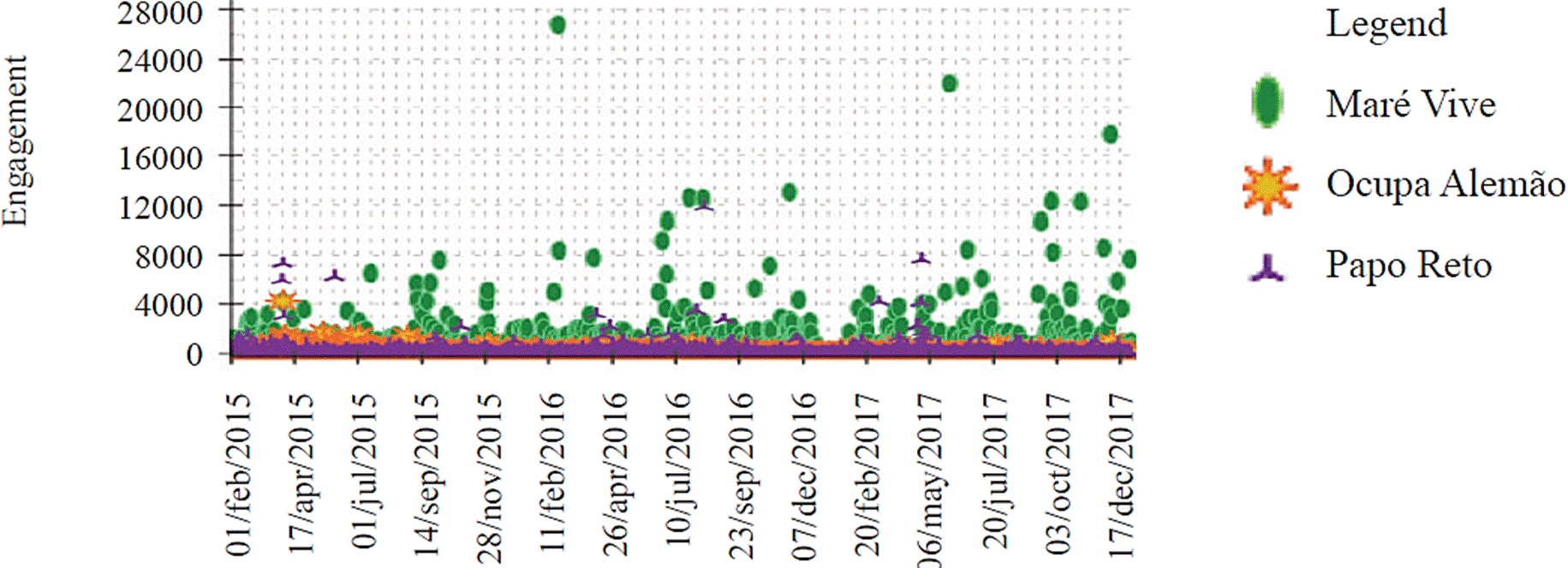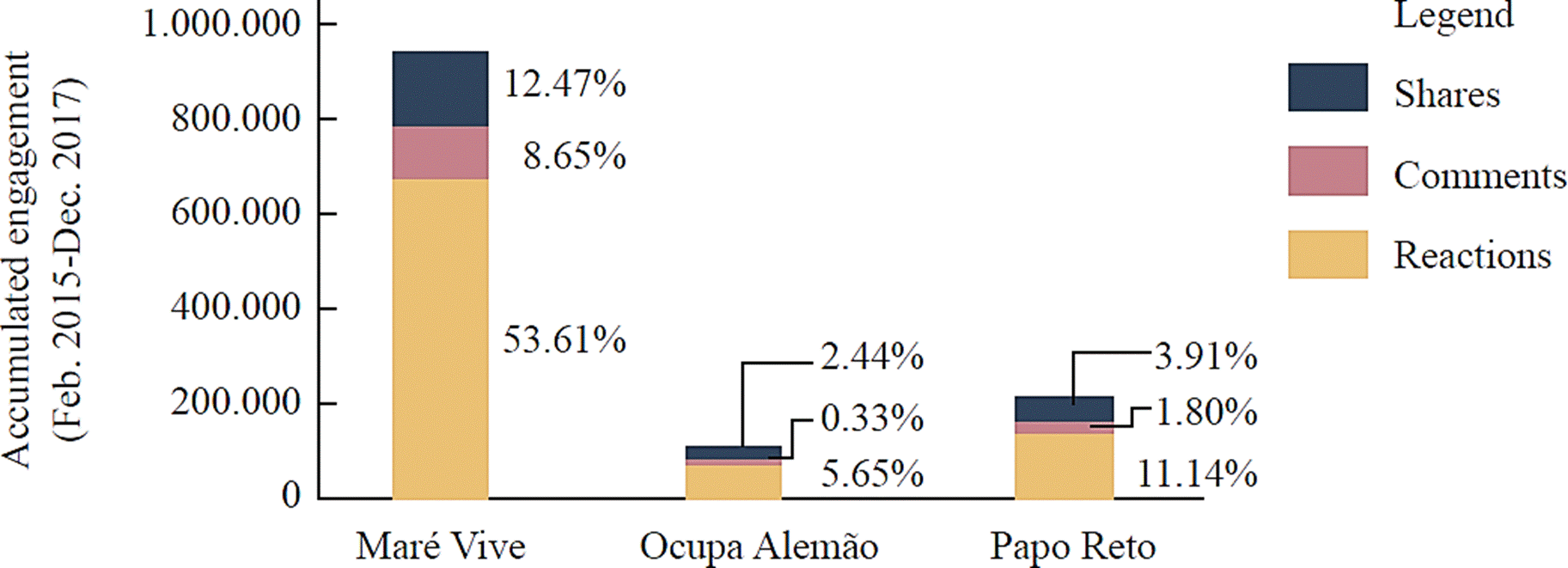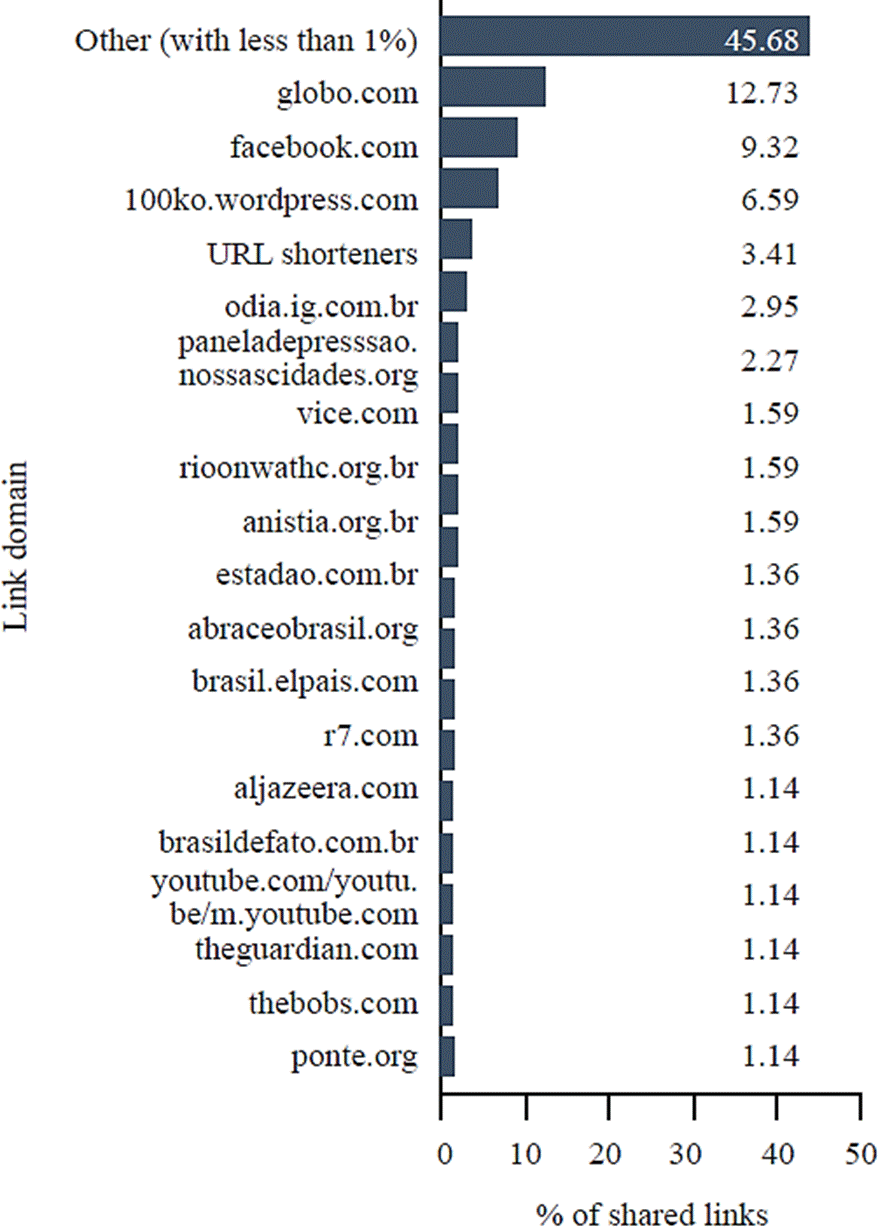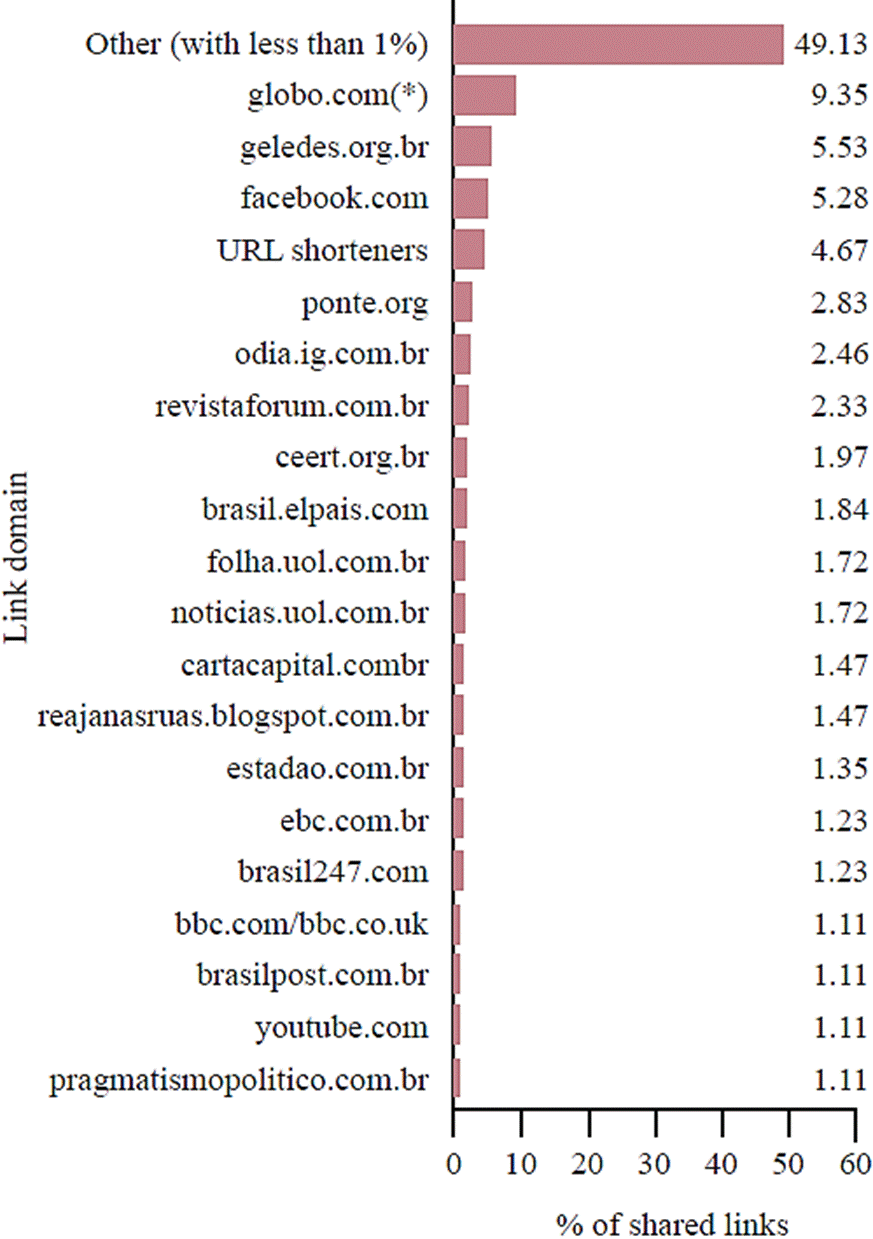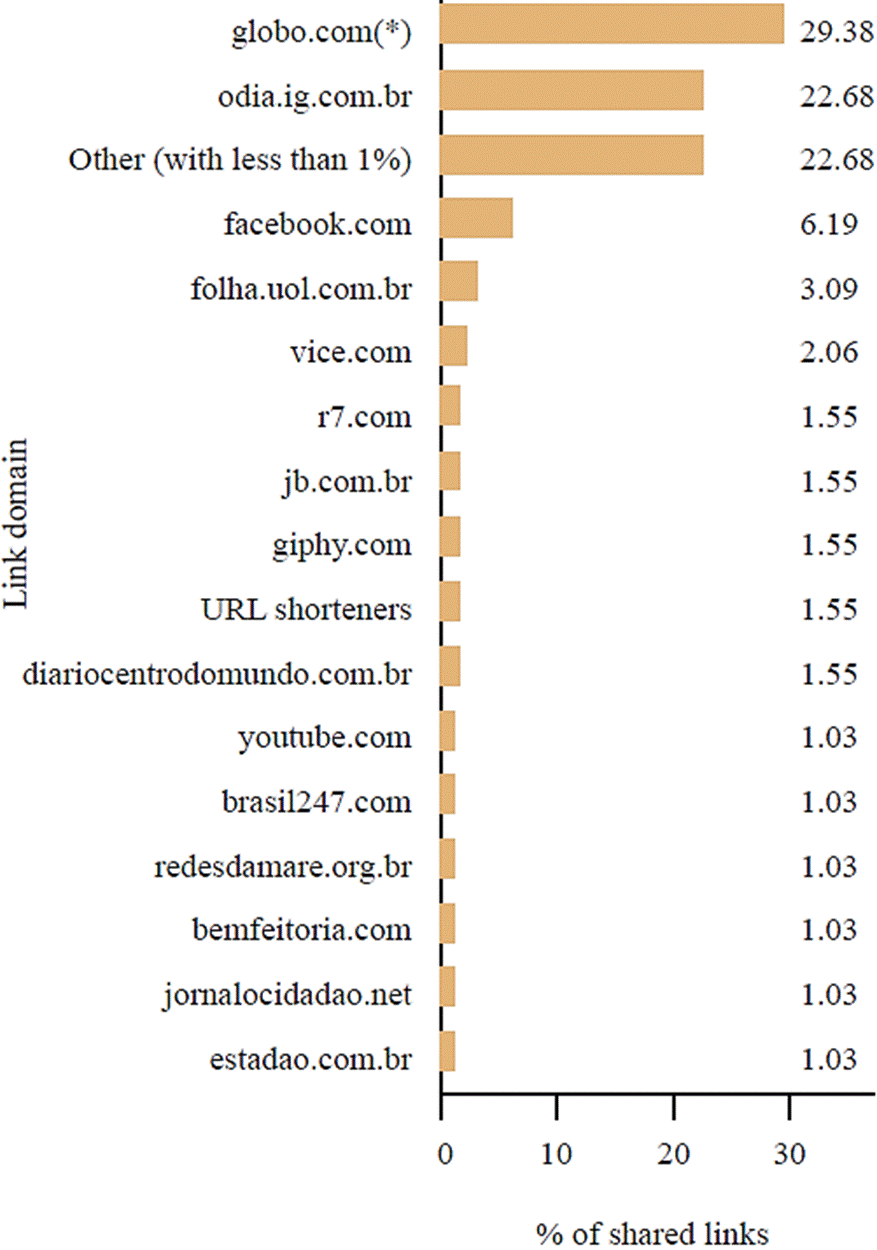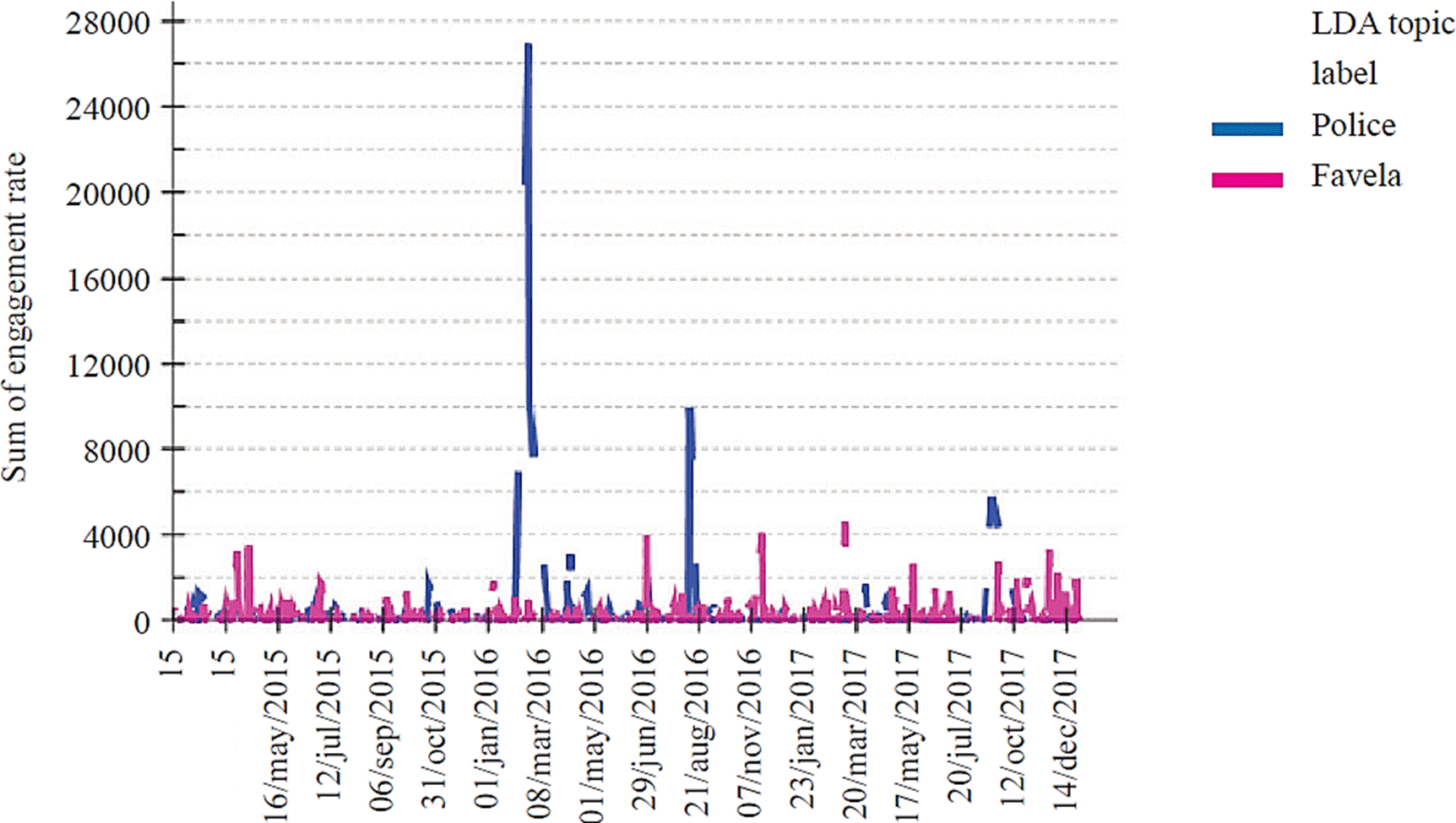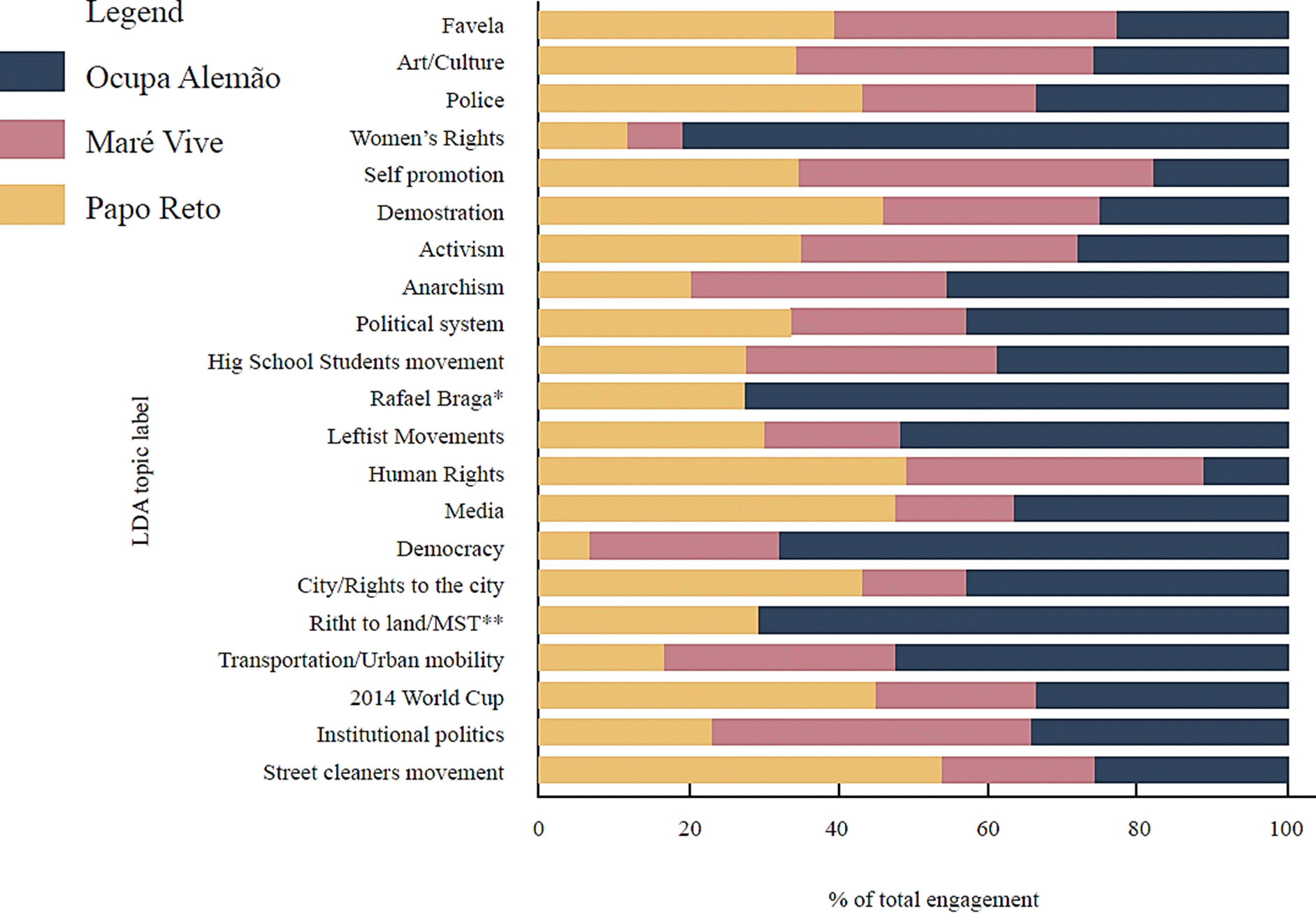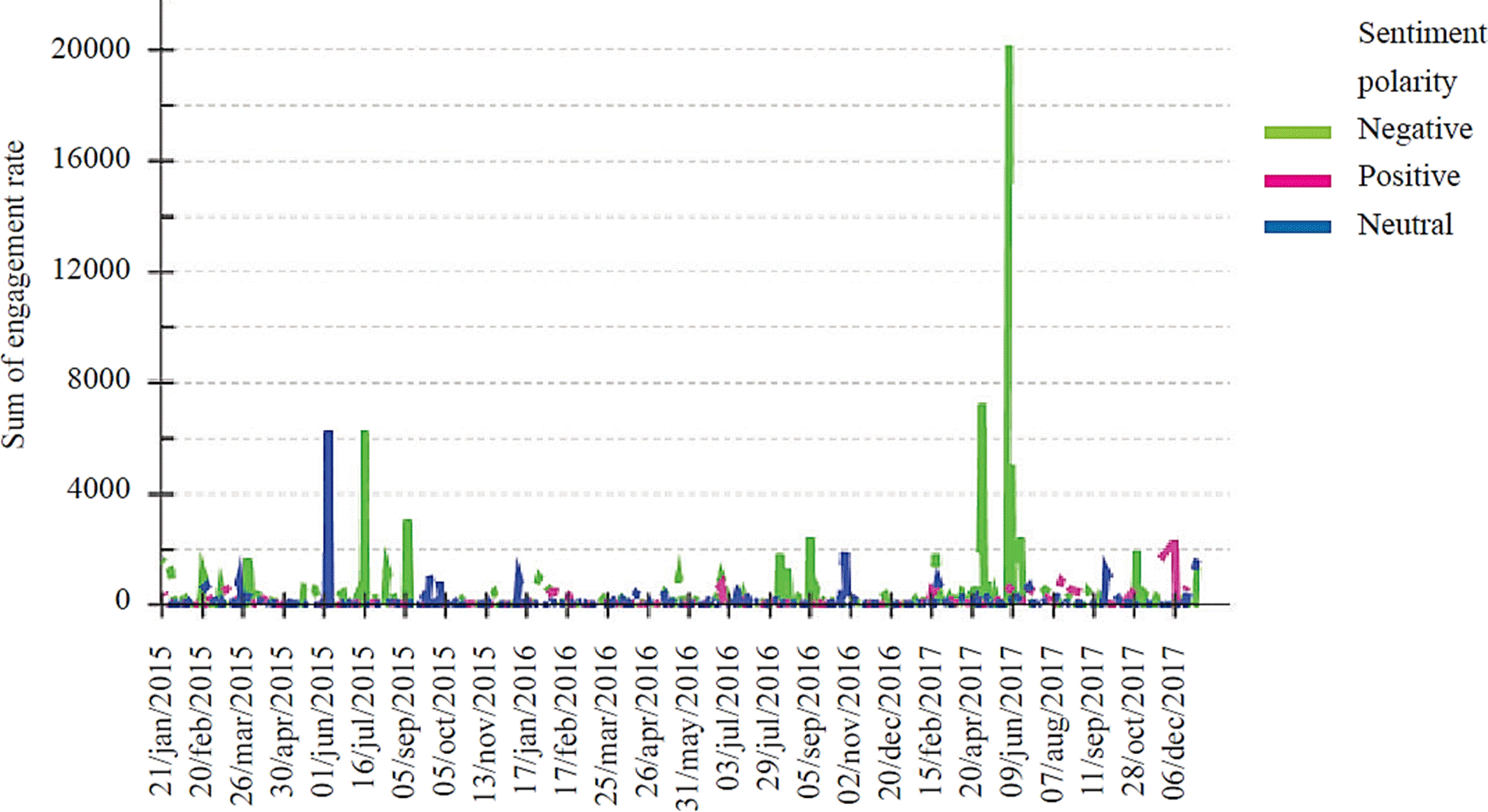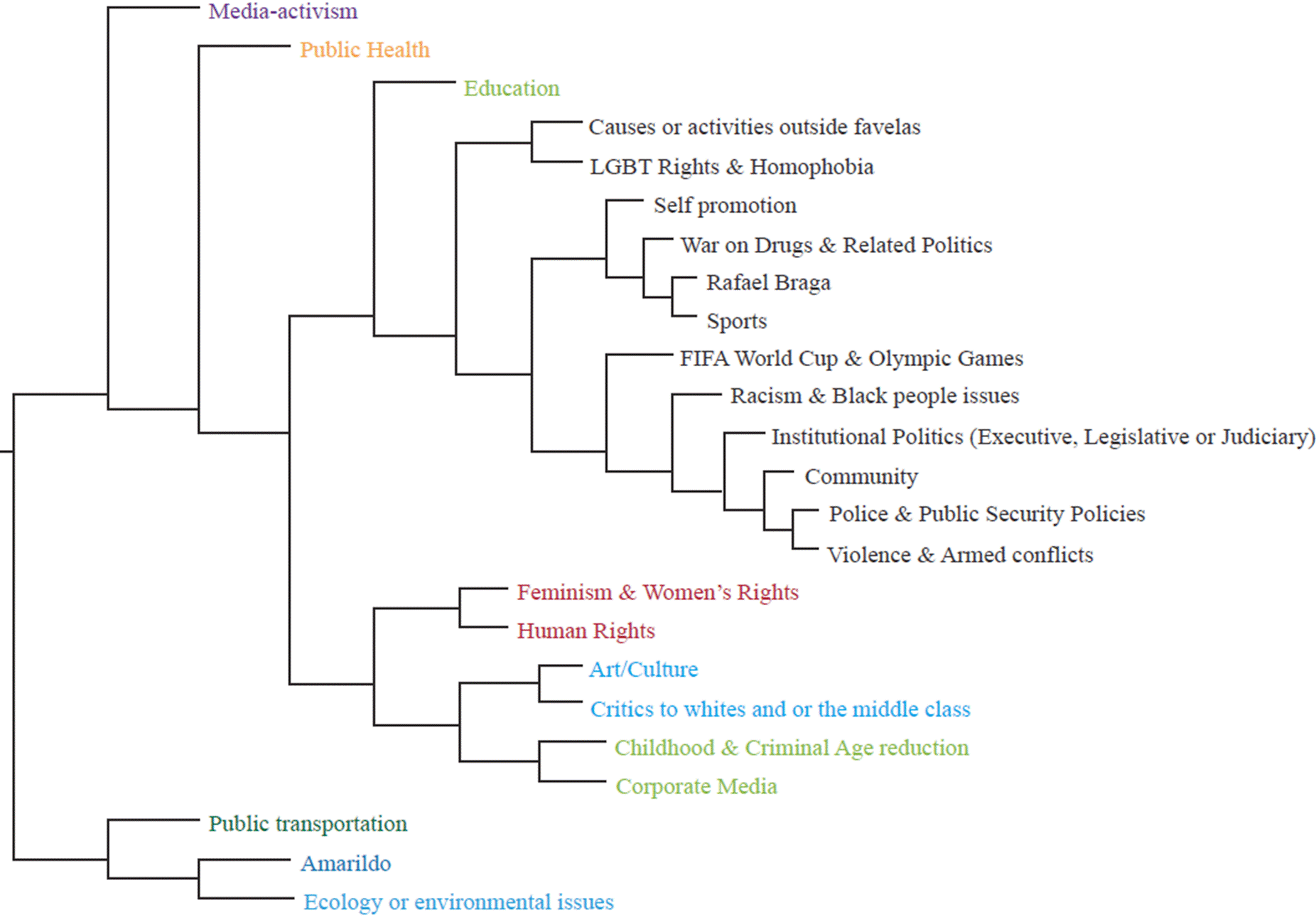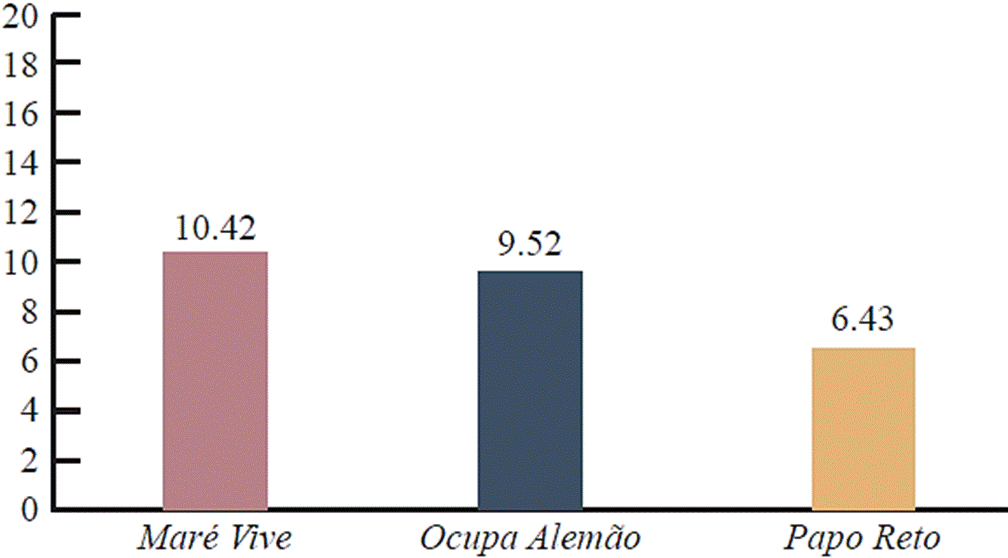Serviços Personalizados
Journal
Artigo
Indicadores
-
 Citado por SciELO
Citado por SciELO -
 Acessos
Acessos
Links relacionados
-
 Similares em
SciELO
Similares em
SciELO
Compartilhar
Comunicación y sociedad
versão impressa ISSN 0188-252X
Comun. soc vol.16 Guadalajara 2019 Epub 20-Maio-2019
https://doi.org/10.32870/cys.v2019i0.727
Tecnopolítica y ciudadanía digital
A data analysis on activist media from Rio de Janeiro favelas
2Universidad de Porto, Portugal. mcanavarro@gmail.com
We present data-driven analyses of activist media produced by inhabitants of the favelas of Rio de Janeiro. The content was collected using their Facebook pages from 2015 to 2017 and was analyzed through computational and manual methods. The analyses reiterate and extend previous research, showing that the collectives are focused on the particular favela 's identity and the demand for rights mainly -but not only- linked to violence, police abuses and state racism. It also presents nontrivial process to look at data produced by media collectives on social networks, by analyzing their posts in an aggregated way through clustering techniques, rather than relying on a few popular posts that may or may not represent their main agenda.
Keywords: Community media; activism; youth; data-driven analysis; multi-methods
En este trabajo se presenta un análisis de datos basado en medios activistas de habitantes de favelas de Río de Janeiro. El contenido se recopiló en páginas de Facebook desde 2015 a 2017 y se analizó a través de métodos computacionales y manuales. El estudio reitera y amplía investigaciones anteriores que muestran que los colectivos se centran en la identidad de la favela y la demanda de derechos, principalmente los relacionados con la violencia, los abusos policiales y el racismo estatal. Además, se propone un proceso no trivial para analizar los datos de los colectivos de medios en las redes sociales a través de técnicas de agrupación (clustering), en lugar de analizar unas cuantas publicaciones populares que pueden no representar su agenda principal.
Palabras clave: Medios comunitarios; activismo; juventud; análisis de datos; multi-métodos
Introduction
The new technologies of communication along with recent improvements access to consumer goods (Ruediger, 2014) by inhabitants of Brazilian favelas have increased the community media production in Rio de Janeiro's favelas. Though these factors alone do not explain the growing number of activist media groups in recent years. A series of massive protests in the country in 2013 have also influenced such a scenario, as the country has seen an ever-growing ecosystem of independent or alternative media production focused on political and social mobilization since then.
In a survey conducted in 2017 for our research, 79.8% of respondents were said to believe that the 2013 "Journeys of June" have positively influenced the credibility of online activism practices, while 60.4% affirmed that traditional media's credibility has decreased. In this paper, we present a data analysis of this kind of media production in three major favelas from Rio de Janeiro -Ocupa Alemão, Maré Vive and Papo Reto-, taking their Facebook pages as case studies, as the platform is the most important channel for them to spread insider information from their communities.
We seek to offer here a comprehensive path to study this kind of media diffusion by exploring the data using a nontrivial process (Fayyad, Piatetsky-Shapiro & Smyth,1996), and thus avoiding the commonly used analysis, which is only based on a set of single relevant posts or random samples. Instead, we explore a topic's relevance through time, based on the automatically learned LDA topics, extracted with the Latent Dirichlet Algorithm (Blei, Ng & Jordan, 2003).
Although it is not our goal in this paper this kind of data-driven perspective may fit well with a detailed ethnographic analysis to deepen the understanding of the work of these groups and the impact on the daily life of their community. We opted to combine the methodology based on an exploratory analysis with graphic visualizations of their activity, the topics' evolution based on an automated qualitative analysis with the LDA, and a manual qualitative content analysis of random samples using 5% of each page's publications. The results of exploratory analysis and qualitative analyses reinforce each other, providing evidence that LDA topics are helpful when researching network-movements and activist media.
Technopolitics
Although the term technopolitics has been referred to for over 20 years to relate technology and politics, it had barely been used as a hybrid of both until the emergence of network movements, in the 2010s. Hecht was the first to introduce the notion of power to the concept of technopolitics when analyzing nuclear technology in France (Hecht, 1998) and the South-African apartheid regime (Edwards & Hecht, 2010). The author sees technology not only as artifacts but also as "non-physical, systematic, methods of making or doing things". In her view, technopolitics are the "hybrids of technical systems and political practices that produced new forms of power and agency". Before Hecht (1998) and Edwards & Hecht (2010) propositions, technopolitics had been mostly applied in the context of e-government practices (Rodotà, 1997) and the strategic use of technology for citizen empowerment (Kellner, 2001). It has mainly revisited the hybridism of technology and politics after the 2010s networked movements that emerged in a range of countries such as Spain, Brazil, Turkey, Iceland, Greece, Egypt, the United States, and Mexico. As previously mentioned, the movement in Brazil in 2013 has strongly influenced the emergence of activist media and has helped to boost the work of these kinds of media collectives in the favelas of Rio de Janeiro, although some of the groups that we analyze here previously existed.
Toret & Calleja (2014) point out that "nor economic conditions nor general social unrest nor, much less, technological enablers are enough to ensure the emergence of network movements" (p. 7). Instead, "these movements have combined the taking of urban spaces in important cities with the organization of networks based on the use of ICTs" (p. 8). They emphasize that technologies have played a variety of roles but "did not 'produce' or even 'drive' collective action" (p. 8). Accordingly, the activist media we analyze here have taken into account sociotechnical practices used by "assemblages or collectives of people and technologies what has spurred mobilization and nurtured new public spaces" (p. 8) in their communities. Therefore, the access to consumer technological goods and Internet connection does not explain alone why this kind of community media have spread through different favelas in Rio de Janeiro. Rather, the emergence of a new context imposed by State forces in their communities nurtured new forms of political action, as we will explain in the next section.
Toret (2013) and Toret and Calleja (2014) suggest that communication from many to many -defined by Castells (2009) as mass self-communication- is an essential element for technopolitical practices as it allows individuals' and collective uneasiness and opinions to have a large-scale reach, which increases their autonomy in relation to restricted circuits of mass media and political institutions. As favela inhabitants saw their lives affected by new police interventions in the community, different groups of activists developed practices of mass selfcommunication, and motivated the broader community to do so as well. Social media was one of the few ways they had to show their perspective and their discontent surrounding the military occupation of their communities, and improved their ability to influence the coverage of mass media. Therefore, "the ability of activists in these movements to combine activity on social networks with the taking of urban spaces helps them to both generate amplifying feedback loops, and to push from different sides potential mass media as well as police cordons that treat to isolate them from other publics" (Toret & Calleja, 2014, p. 9).
In this sense, technopolitics is characterized by the "tactical and strategic use of digital tools [and] collective identities online for the organization, communication, and collective action" (p. 41). It is useful to emphasize that technopolitics is not "clicktivism" (Morozov, 2009; Nonneke & Preece, 2003; Peña-Lopez, 2013) neither cyberactivism (Tascón & Quintana, 2012) because these concepts lack the notion that political action must be simultaneously in digital networks and physical spaces to be characterized as technopolitical. The massive use of ICT'S has served as an initial step for the maturation of a socio-political autonomy, but it is not enough to explain why the Internet has worked as a connector able to link physically distant networks in a disruptive way.
Different authors (Sampedro & Duarte, 2011; Toret, 2015; Monterde, 2015; Calleja-Lopez, 2017; Oxfam, 2016; Treré & Carretero, 2018) emphasize that technopolitical practices rely on hybrid spaces, i.e., in such a constant "loop between action online and offline, between digital and urban spaces" that it turns impossible to separate both spaces. In Treré & Carretero's (2018) words, "technopolitics is based on the innovative and smart strategic uses of technologies by activists through different platforms (inter-platforms) and layers (multilayers), which include the connection between online and offline strategies from a nondeterministic view" (pp. 54-55). The analysis of the favelas' activist media on which we focus here reinforces such claims. The content analysis points out that their coverage online is intrinsically linked to their communities' physical activities, many times promoted by inhabitants to be mediatized thus improving their sense of pride and belonging in their neighborhoods.
We define technopolitics as "an action-and-reaction dynamic between hegemonic and counterhegemonic forces in hybrid spaces in order to achieve political influence or dominance in a given topic or political field" (Canavarro, 2019, p.70). We, thus, emphasize that technopolitics is not only reactive nor is it exclusively a means to inspire resistance to government. Technopolitical practices' may originate either on dominant or dominated sides and it frequently leads to a reaction from the implicated counterpart who seeks to conquer or amplify their presence in the same kind of hybrid spaces, by combining the physical and the digital. Although we do not analyze the mainstream commercial media in this paper, it is the privileged space used by State forces to challenge the narrative of communitybased storytelling on controversial governmental policies in favelas. In turn, social media channels cast the communities' discontent to a broader audience outside of the favelas, competing with the official versions disseminated on corporate media. The media work done by activists in Rio de Janeiro's favelas is based on true technopolitical practices because, by simultaneously relying on the community's physical spaces and online networks, it aims to influence public opinion inside and outside of their territories, many times using hegemonic media sources -which agenda they eventually influence- the government's official statements with the factuality of their versions.
Rio de Janeiro favelas' activist media
Souza and Zanetti (2013) relied on interviews to investigate the relationship of poor youth with communication technologies to create "new democratic public spheres" (p. 4), focusing on three distinct categories: Culture & ICTs, Gender & Young Women, and Favela's identity (p. 8). The authors mention a "great variety of socio-economic profiles" (p. 10) and a "clear engaged or militant co-formation ethos in which the interviewees present themselves publicly" (p. 12, own translation). Aligned to our technopolitical approach to examine such practices, the authors highlight that online and offline are part of the same continuum and thus treating them as a dichotomy is hardly useful:
The idea of territory extrapolates the physical space to which specific experiences attribute meaning. Research territories also appear on social networks in which they do not stop to post denounces, testimonies, pictures, even when they are being interviewed. Physical and virtual (or online and offline) are not treated as different places, but like a continuum of this generation's experiences. We have learned with this investigation that dichotomies have little value to explain practices and experiences by this generation ... The Internet and social networks have opened the possibility for the subjects to express individual opinions. Nevertheless, it is the fact that they are participating in collective spaces, being part of networks outside the Big Network, that gives sense to such mobilizations and actions both for them and for those whom they seek to mobilize (Souza & Zanetti, 2013, own translation).
Custódio (2016) identifies a variation of Souza and Zanetti's categories, including the demand for rights, in a broader meaning than those related only to gender and identity issues. He mentions that favelas' activist media use a tactical appropriation of privately-owned social media platforms "combined with journalistic skills to mobilize collective actions and demand respect for rights" (p. 133). Production and circulation processes of "textual and audiovisual materials for mobilization of collective action" in favelas "include interactions on social networks online and especially offline" (Custódio, 2016, p. 125). Both Souza and Zanetti's and Custódio's studies on the media activism of impoverished youth are likely to support a technopolitical. Custódio acknowledges the relevance of new media technologies on the appearance of such collectives in Rio de Janeiro though reinforcing that "it is also crucial to avoid false dichotomies between the real and the virtual concerning media activism in favelas" (2016, p. 125).
According to him, media channels are used in constant interaction with physical events, which may be, for instance, a community activity or a police operation in the favela. Custódio (2016) tells that he has observed independent citizen-led initiatives which use media-related skills (e.g., photography, documentary production, journalism, web-design) to act together for rights and social justice in favelas. These collectives consisted of small groups (often between three and twelve people) formed by some established relationship of affinity and/ or geographic proximity (p. 125). The author's work reinforces that favelas' activist media use technopolitical practices to fight for certain rights that are frequently neglected by hegemonic forces -such as the state and the mainstream media- and dispute the dominance of their version of the truth to the public inside and outside of the favelas.
Souza and Zanetti also emphasize the close relationship between the media collectives they analyzed and the mainstream media, but they avoid to take for granted the usual dichotomy between the activist and the commercial production:
The content created by the researched collectives, groups and people can be seen as part of the new field of information which sometimes is opposed to the content produced by commercial media, but other times is profoundly related to it, either criticizing or adhering to it and confirming it, but they do have it as a strong reference (Souza & Zanetti, 2013, p. 30, own translation).
In our analysis, we follow Souza and Zanetti's category of "favela identity", and Custódio's approach on "demand for rights" as our data indicates that such categorizations are correct when it comes to the activist media in Rio de Janeiro's favelas. Our work is complementary to theirs as we focus on a data analysis of their coverage agenda, while Custódio analysed the collectives' environmental culture and processes; and Souza and Zanetti relied on a qualitative ethnographic approach. An interesting methodology for future research is to combine these three methodology for an in-depth study of this particular subject.
Cases of study: 'Ocupa Alemão', 'Maré Vive' and 'Papo Reto'
Complexo do Alemão (Alemao Complex) is a complex of more than 50 favelas located in the Northern region of the city of Rio de Janeiro. The last official data by the Brazilian Institute of Geography and Statistics (IBGE) was released in 2010 Census and stated that nearly 70 0002 people resided there numbers that have certainly increased since then-. Despite a diverse history and community background, Complexo do Alemão is largely seen by Rio de Janeiro's population as violent, which is the reason why the State administration decided to occupy its main favela -Morro do Alemão- with the Brazilian Army, in 2010. The operation was reported live from a commercial television helicopter and has caught the attention of a national audience with scenes of fleeing drug dealers.3 Two years later, the Army would be replaced by the Pacifying Police Unit (UPP), one of the main policies implemented to improve Rio's security for the 2014 World Cup and the 2016 Olympic Games. Despite some improvements for favelas inhabitants, the UPP program has created controversy over the effects of a military presence imposed on their daily lives.
Custódio (2016) clarifies that the media collective Ocupa Alemão (Occupy Alemao) started in 2012 when the UPP was replacing the Army. At first, its name was just a hashtag: media-activists used #OcupaAlemão at Complexo do Alemão to exchange information with Morro do Borel, another favela with an ongoing UPP unit release, and whose community used the hashtag #OcupaBorel. Technopolitical practices are intrinsically linked to the story behind the collective's name and history. Ocupa Alemão was born from an online mobilization spurred by an external physical intervention in the community, and promoting a constant "loop between action online and offline, between spaces" (Toret & Calleja, 2014, p. 9) to trigger affections and emotions able to connect people and to create collective political action. Even though the physical and political action -the favela's occupation- was not created by the activists, they did show great ability to combine the activity on social networks with actions in urban spaces to "generate amplifying feedback" that has strongly influenced the commercial media's coverage and Brazilian society's reaction to the "police cordons that treat[ed] to isolate them from other publics".
Although the administrations at City, State, and Federal levels focused on the narrative of improvements on favelas inhabitants' lives, "at the end of 2012 various favelas faced a number of conflicts despite or in some cases because of the implementation of the Pacifying Police Units (UPP)" (Custódio, 2016, p. 127). Ocupa Alemâo's self-description on Facebook corroborates Custódio's claims: "Ocupa Alemão was born from death, pain, caused by institutional racism, the State violence against blacks and favelados"4 (own translation). Custódio (2016) also noticed an increase in "confrontational discourses and actions" by Ocupa Alemão, probably due to an increase in violence in the complex of favelas since the UPP implementation. Nevertheless, according to Ocupa Alemão's members, the collective's main goal is "having open-mic or talk-circle events in open areas inside the favela to discuss governmental neglect, lack of cultural and leisure facilities and other themes arising from everyday problems" (Custódio, 2016, p. 128). Such themes transpose issues related to the favela's identity/ pride, and the State's neglect and violence into communicative practices -both online and offline- that can not only relieve their pain but also dispute the decisions of hegemonic forces about their own fates.
The history of Coletivo Papo Reto ("Collective Straight Talk", in plain English) is similar to Ocupa Alemão's. It is also an initiative born at Complexo do Alemão - in fact, after disagreements on how to conduct their work, some young media-activists who left the collective Ocupa Alemão founded Papo Reto (Custódio, 2016, p. 131). The group has gathered "to communicate in clear and direct terms with residents and outsiders about the everyday-life struggles in Complexo do Alemão and other favelas in Rio de Janeiro" (Custódio, 2016), using social media platforms and mobile phone applications, along with face-to-face interactions. According to Custódio, "one of their main types of actions is reporting and denouncing police violence" although the collective has also focused on campaigns for leisure and culture in the complex of favelas it represents and for artistic political demonstrations (p. 131). Due to a professional background by Papo Reto's members, its materials tend to be at an independent pro-level despite resource limitations.
Like Ocupa Alemão and Papo Reto, the collective Maré Vive ("Mare Lives", in plain English) is managed by inhabitants at a complex of favelas, located at the North region of Rio. According to IBGE Census,1 in 2010 almost 130 000 people resided at Complexo da Maré. The collective Maré Vive is a relevant example of the use of social networks and mobile phone applications to produce and circulate information from and about favelas. Its collaborators are more concerned about protecting their identities as compared to the other two collectives we analyze here. While Papo Reto's members use some level of visibility to help them to deal with the risks of frequently denouncing abusive police conduct, Maré Vive's media activists sought to be as discrete as possible, treating the collective itself as the protagonist. Custódio mentions not having the chance to meet them for his research interviews, and that was also our experience when doing field research for our study on activist media in Brazil.
Maré Vive's origin is a response to the occupation by military forces as well. As described by Custódio, the group's actions took off online in early 2014 by announcing a live stream of the Brazilian Army Occupation in the complex of favelas in Maré. According to him, at that time, Maré Vive's live coverage focused on presenting residents' opinions, evaluating levels of danger in different areas inside Complexo da Maré, and commenting on reports from commercial television channels. Residents could participate by sending private messages on Facebook or via WhatsApp. These comments would then appear on Maré Vive's newsfeed, either signed or anonymously, under the pseudonym "Resident of Maré". The information on their page contrasted with the live coverage of the mainstream media which mainly celebrated the occupation and focused on the official reports by the government and military authorities (Custódio, 2016, p. 133).
Since their release, Papo Reto, Ocupa Alemão, and Maré Vive continued to focus their agenda on the inhabitants' safety, either informing them when/where to take precautions due to armed conflicts or by denouncing police abuses. They also strongly focus on reaffirming their pride in the favela's cultural heritage and their sense of community, as our data confirms.
Methodology: a nontrivial process to learn from data
We use Facebook data and metadata from posts published on the pages Maré Vive, Ocupa Alemão, and Papo Reto, from 2015 to 2017 -a period that marked the prominence of activist media in Brazil due to many political mobilizations in institutional and non-institutional politics-. The data was collected with the Netvizz application (Rieder, 2013) on different dates from 2015 to early 2018. For computational processing purposes (i.e., topic modeling), we used a larger dataset with 684 361 posts published from 2010 to 2017 by either pages or users on 252 Facebook activist pages positioned in different ideological fields. We selected them based on observational criteria, considering their participation in the recent rise in activist media in Brazil. The variety of pages helped the algorithms to process data for diverse tasks related to data cleaning, tokenization, sentiment polarity detection, and clustering for automatic topic modeling. The Latent Dirichlet Algorithm, or simply LDA (Blei et al., 2003), is a clustering technique that combines groups of words that tend to appear together or very close in a given set of documents, thus indicating their general semantic field.
The concept of topic was only abstractly presented by Blei et al. in their proposal of the LDA clustering algorithm. Maier et al. (2018), instead, state that "the LDA algorithm aims to model a comprehensive representation of the corpus by inferring latent content variables, called topics" (p. 2). Thus, in the context of automated qualitative analysis with the LDA, topics are the result of an inference process that finds clusters of similar posts, accordingly to their common semantic field. An expert then revises the groups of words detected to label them in a way that is easily recognized. Therefore, each cluster of posts represents a general theme, or agenda. Maier et al. (2018) state that, unlike a "simple co-occurrence analysis, a topic model can reveal a latent semantic connection between words, even if they never actually occurred in a document together" (p. 96) in the analyzed dataset.
In our work, we extracted 60 topics with ten words each, resulting in 34 final topics, as some different groups of words were assigned to the same label and some others to the label Miscellaneous due to the lack of clarity on what they were about.
All data is currently indexed on the Web platform Tecnopolítica Brasil (Canavarro, Pasquali & Jorge, 2018a, 2018b; Canavarro, 2019), developed by an interdisciplinary team at the Laboratory of Artificial Intelligence and Decision Support (LIAAD/InescTec, University of Porto, Portugal). The platform integrates filters generated by diverse computational processes using different algorithms. The filters allow users to subset data and to export the resulting search as CSV or JSON files. For this article, we subset all posts published by the three analyzed pages and timeframe (2015-2017), and used R Studio to subset such datasets again in order to separate publications by type (photo, videos, links, etc.) and to extract random samples for content analysis. The resulting datasets gather 6 416 posts published by any Facebook page at Maré Vive's, Ocupa Alemão's, and Papo Reto's timelines. Posts by users (n=2 010) were not part of content analysis as our primary goal is to understand the pages' coverage agenda, and due to concerns on ethical issues related to using individuals' data without informed consent. However, user's Facebook events were included on content analysis as they were published with the goal to spur collective action through the pages. Users' posts were also considered for basic statistics in an aggregated way, thus preserving sensitive information.
We opted to focus on different graphical views on a few indicators (e.g., engagement, number of posts) on the selected pages' activity (e.g., frequent topics, frequent link domains), for a comparison among the pages. We used the statistics per day provided by Netvizz for the exploratory analisis of Maré Vive's, Ocupa Alemão's and Papo Reto's activity, showing relations between the engagement rates (sum of likes, reactions, shares, and comments) and the number of posts. The qualitative analysis relied on an inductive approach to analyze the content of a random sample of 5% of each page's posts (videos, photos, links and status updates) and all Facebook events published on their timelines (n=240). We coded 83 posts by Papo Reto, 84 by Ocupa Alemão and 97 by Maré Vive, at a total of 264 posts analyzed, using the software for qualitative analysis NVivo. Figure 1 shows a summary of the applied methodology.
Data analysis: exploratory graphical views and topics' evolution
While Papo Reto and Ocupa Alemão have similar posting frequencies, Maré Vive shows quite higher activity, reaching more than 40 posts at the peak-day, in 2017 (Figure 2). That is mainly due to users' activity on the page's timeline, responsible for 44.4% of all posts on Maré Vive, suggesting that the collective has a closer relationship with its community when compared to the other two. Posts by users are 28 times more frequent on Maré Vive than Ocupa Alemão and more than seven times more frequent than on Papo Reto.
Maré Vive also shows stronger user engagement rates during the analyzed period, reaching 26 772 interactions at a single day in 2016. Ocupa Alemão and Papo Reto show similar engagement rates, especially after September of 2015 (Figure 3). More than 74% of the pages' engagement were directed to Maré Vive's page, which accumulated 939 987 likes, reactions, comments and shares (engagement) from 2015 to 2017. Papo Reto and Ocupa Alemão accumulated respectively 211 950 and 105 907 interactions during the same period (Figure 4). Although users posted more than 40% of Maré Vive's publications, only nearly 0.003% of all engagement was directed towards them, suggesting that the tactical and strategic uses of communication networks are quite relevant to foster community participation.
Reactions were the most common type of user interaction on the pages while comments represented a slight portion of Ocupa Alemão and Papo Reto but appeared at a much higher rate at Maré Vive (Figure 4). If we consider that commenting is more of an engaged activity than just liking a post, these numbers reinforce that Maré Vive's audience is more involved in the page compared to the other two. Nevertheless, a detailed analysis of the content of such comments may reveal new insights that corroborate or negate this assumption, revealing clues to the connective practices of users (Bennett & Segerberg, 2012) and collective digital practices (von Bülow, Vilaça & Abelin, 2018) through Maré Vive's timeline. Even though high engagement rates appear on days with many posts, this is not true when it comes to the highest engagement rates (Figure 5) during the analyzed period. In fact, higher publishing rates do not necessarily lead to higher engagement rates, suggesting that high quality content is more relevant than quantity to achieve users' involvement. How Facebook positions posts by users for the pages' audience visualization is also an important factor.
Our datasets gather 1 468 posts by pages with links shared on the pages. They come from 386 different sources (link domains). We looked at the most shared domains to find out which ones were the usual sources used by the pages, as well as their distribution. Papo Reto (Figure 6) and Ocupa Alemão (Figure 7) show a similar type of distribution, with more than 45% of unique links from many different sources shared at low rates (each one represents less than 1% of total shared links). Nonetheless, the most frequent link domain in all pages is globo.com, which includes different sub-domains owned by Globo corporation, the most powerful commercial media group in Brazil. While Maré Vive (Figure 8) shows a sharper scale-free distribution than the other two pages, it also relies more often on the content produced by the mainstream media (YouTube). The scale-free distribution is also strongly marked in Figure 9, which shows the accumulated engagement rate on the 296 most shared unique links on the three pages, aggregated by domain. More than one-fourth of users' interactions were directed to domains that represent less than 1% of all links in frequency.
The most constant domain, globo.com, also attracted most of the users' attention, with 35.2% when we aggregate all its sub-domains. Another corporate domain, odia.ig.com.br, gathers alone more than onefifth of users' engagement (21.2%). Amongst the unique links with the highest engagement, with a rate of 120 or more (Figure 9), only revistaforum.com.br, brasil247.com, ponte.org, and kickante.com.br are not part of the mainstream media ecosystem.
Maré Vive, Papo Reto, and Ocupa Alemão have 240 posts with links calling for events, either published by users or pages. From such publications, those classified under the LDA topic Art/Culture attracted most of the users' engagement (Figure 10), although the topic Police appeared with the highest engagement rate in a single day (Figure 11) and a strong accumulated engagement throughout the analyzed period. Figure 12 shows the engagement in events disseminated in the pages. All three pages shared nearly half of the discovered topics: Art/Culture, Favela, Self-promotion, Police, Political System, Activism, Leftist Social Movements, Rafael Braga, and Demonstration.

Source: Own elaboration.
Figure 10 'Art/culture'; 'Police', topics with the highest accumulated engagement on events

Source: own elaboration.
Figure 11 'Police'; 'Self-promotion', topics with highest engagement on a single day
The datasets gathered 2,319 photos published on the pages' timelines by themselves or other pages. The word cloud built with the three pages' frequent vocabulary (Figure 13) shows that posts with photos were often referencing their communities: Complexo, Alemão, Papo, Reto, Maré, favela, inhabitants and people were among the most common words, along with fight, state and the hashtags #FavelaSempre ("Always Favela") and #NósPorNós ("We For We"). A similar trend appears in posts with videos.
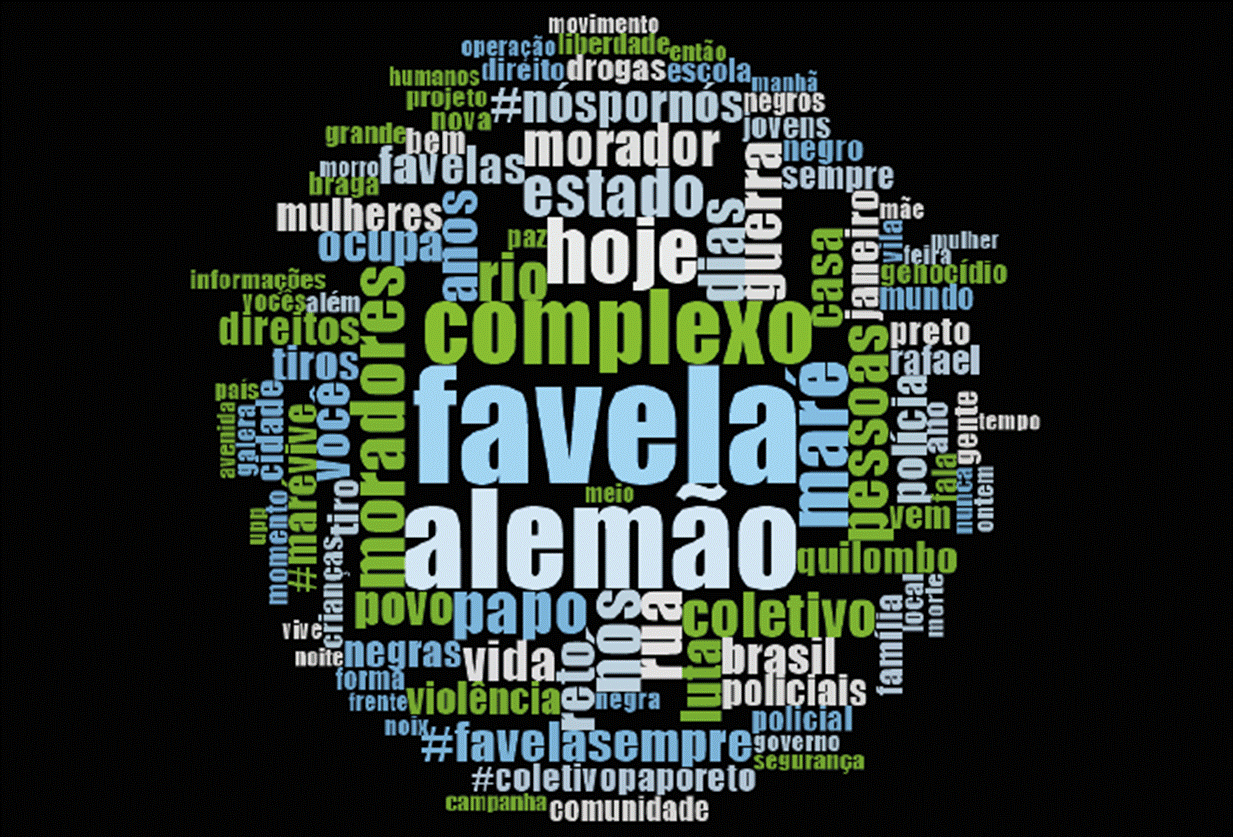
Source: Own elaboration.
Figure 13 Frequent vocabulary on messages published with photos (all pages)
By comparing posts with photos by the automatically detected sentiment polarities, we see that negative and positive publications appear at similar rates during the analyzed period, with slightly higher frequencies of negative posts (Figure 14). Such a result should be analyzed along with Figure 15 which shows that Favela and Police were the topics that most attracted users' involvement in photos.
The analyzed media collectives often posted strong critiques to the police (negative polarity) while they used the same space to highlight what they considered the true and dearest cultural aspects of their communities (positive polarity). Figure 16 shows that the topic Police reached much higher user engagement on photos in a single day, but Favela attracted their attention more frequently. The references to the police probably followed the days with the State forces' operations in the community. For a comparison between pages, Figure 17 shows that users' engagement on photos is more evenly distributed on different topics than on events.
Posts with videos (n=1 070) reached higher user engagement if compared to other types. Once again, self-referencing vocabulary is the most frequent kind on texts related to posts with video, but negative polarity prevails in these kinds of publication (Figure 18). Note that videos are frequently used to denounce abusive conduct by the police. Favela and Police appear again as the most common topics, followed by Demonstration and Human Rights (Figure 19).
Figure 20 shows the temporal distribution of users' engagement with videos: Favela goes on as the most frequent topic and it also reached the highest engagement rate in a single day. Figure 21 shows how engagement with videos was distributed through topics and pages.
Content analysis
Reinforcing the analysis' of the topics' evolution -which indicate that the self-referencing topic Favela and the external one Police were the highlights on the pages' agenda -the manual qualitative showed analysis also showed a prevalence of the topics Community, Police & Public Security Policies, and Violence & Armed conflicts-. Though there is not a complete detachment to traditional framings by social movements in Brazil -like Public Health, Transportation and Education - or other generic causes- such as Environment, the two main clusters of thematics do not include them (Figure 22).
The main cluster shows that Police & Public Security Policies and Violence & Armed Conflicts are often related to each other and to Community, as such thematics are also commonly part of the everyday life in favelas. Even when the message is related to favela pride, it commonly mentions the violence and the presence of the State's forces, highlighting the need to be strong and to resist to them. The thematic Racism & Black people issues is frequently related to the police but also to community pride, while many problems are attributed to Institutional Politics. The few mentions of the Corporate Media are mainly criticizing their coverage of the legislative proposition of reducing the age when accused individuals are charged as adults to 16 years old which is seen as a factor which will lead to more violence against black youth living in favelas. Board 1 shows all thematics (in alphabetical order) manually coded, with their respective frequencies and the number of pages that mention them.
Board 1 Thematics manually coded from pages’ random samples (N=264 posts)
| Thematic | Description | # of pages | # of codes |
| Art & Culture | Focused on cultural production in favelas or outside |
3 | 12 |
| Causes or activities outside favelas |
Not occurring in the favelas, it can be
about any external topic |
3 | 24 |
| Childhood &
Criminal Age |
With a central
thematic on the reduction in the age at which one is tried as an adult |
1 | 3 |
| Community | Focusing on favela pride, the everyday life in
the community, messages of mutual support or crowdfunding campaigns for local causes |
3 | 69 |
| Corporate Media | Direct mention of the corporate media’s coverage | 2 | 6 |
| Whites & middle- class | Direct mention of white and middle-class
people’s roles in helping to constrain the violence in favelas |
2 | 3 |
| Education | With a central focus on Educational issues | 2 | 3 |
| Feminism & Women’s Rights | With a central focus on feminist causes or
testimonies and/or Women’s Rights |
3 | 5 |
| World Cup & The Olympic Games | Direct mention of
the big events in Rio de Janeiro, which had a large impact on life in favelas |
2 | 3 |
| Human Rights | Discussing Human Rights or denouncing violations of basic rights | 1 | 4 |
| Institutional Politics | Referring to the
Executive, Legislative or Judiciary, or authorities linked to them, or bills under discussion |
3 | 13 |
| lgbt Rights | Focus on lgbt pride or homophobia | 2 | 3 |
| Media-activism | Self-referencing to activist media practices | 1 | 3 |
| Police & Public Security Policies |
Focused on the State’s policies, either in the
community or outside, or any mention to the police or to a singular policeman |
3 | 70 |
| Public Health | Central focus on the public health system | 1 | 2 |
| Public transportation | Central focus on transportation or fare rise | 1 | 1 |
| Racism & Black
people issues |
Denouncing racism
either in the community or outside; focusing on Black pride, history or specific issues |
3 | 32 |
| Rafael Braga | Issues related to the favela inhabitant
arrested in the 2013 protests and convicted in Court |
2 | 5 |
| Self-promotion | Self-referencing to the collective’s activities | 2 | 12 |
| Sports | Central focus on sporting activities at or outside the favela | 1 | 1 |
Source: Own elaboration.
The pages did not evenly distribute their key thematics. While Racism and Black people issues, including frequent mentions to Black pride and their ancestors' history, is a dear topic to Ocupa Alemão, it rarely appeared on Maré Vive's sample (Figure 23). The opposite occurs when it comes to the everyday life in the favelas and the community-centered pride, in which Maré Vive is the highlight while Ocupa Alemão is the page least concerned with it (Figure 24).
The thematics Violence & Armed Conflicts and Police & Public Security were common in all analyzed pages (Figures 25 and 26). Again, Activities in the favela and Violence were the most frequent thematics on event calls, though the sense of community was strong in such a kind of post, with 79 references to calls for local activities in the community, while calls related to violence summed up 22.
Conclusions
The coverage agenda highlighted in the topics' evolution and the manual qualitative analysis indicate that neither ICTs popularization nor social unrest are enough to explain the rise of activist media in the favelas of Rio de Janeiro. In fact, a complex network of physical factors (such as the 2013 protests' affinity for online activism practices; the insecurity brought to the inhabitants of favelas by the large sporting events and the UPPs; and the economic improvements for the lower class during the former president Lula's era) and material enablers (not only the ICTs but also some support from international NGOs like Witness and Rio On Watch, perhaps catalyzed by the aforementioned physical factors) took important roles in the rise of technopolitical practices in favelas.
Such practices tried during the Journeys of June were improved upon in the following years, reshaping the use of technologies and social practices. A good example is a partnership between Papo Reto and Witness. One of its achievements was the release of a mobile application to register abusive police conduct in a means that it could be used in court. The way in which local people communicated through the collective pages (in special Maré Vive) and WhatsApp (mainly with Papo Reto) also show that technopolitical practices have reshaped how local people build a network of information. The goal is not only to improve their ability to face the frequent violence that confronts these communities but also to reinforce their own connections through local culture and art. The media collectives work as a quasi-central brain to process incoming information from different parts of the favelas. Another prevalent example is the increasing number of demonstrations at the entrance of such communities after somebody is killed there during an operation by the police. The rising of iconic cases of police abuses -such as the murder of the dweller Amarildo and the arrest of Rafael Braga- is also helping to raise awareness elsewhere to their fight for rights.
Our analyses reinforce previous categorizations on activist media practices, such as the demand for rights, favela's identity, and culture & ICTs, extending such analysis to a data-driven approach with social media data. It also reiterates the close relationship of such collectives with the commercial media, adding to it a broader understanding of how much attention users direct to each of the external sources.
Finally, the automated qualitative analysis relying on computational methods, in particular the LDA topics, presents a nontrivial way to analyze data, avoiding extremely partial views of single popular posts that may not reflect the groups' actual agenda. Additionally, the analysis based on graphic visualizations is strongly reinforced by the qualitative and manual qualitative content analysis, showing a reliable process to investigating grassroots media production on social networks.
REFERENCES
Bennett, W. L. & Segerberg, A. (2012). The logic of connective action. Digital media and the personalization of contentious politics. Information, Communication & Society, 15(5). DOI: https://doi.org/10.1080/1369118X.2012.670661 [ Links ]
Blei, D. M., Ng, A. & Jordan, M. I. (2003). Latent Dirichlet Allocation. Journal of Machine Learning Research, 3, 993-1022. Recuperado de https://dl.acm.org/citation.cfm?id=944919.944937 [ Links ]
Calleja-Lopez, A. (2017). Since 15M: the technopolitical reassembling of democracy in Spain (Tesis doctoral). Universidad de Exeter, Reino Unido. [ Links ]
Custódio, L. (2016). Favela media activism. Political trajectories of low-income Brazilian youth (Tesis doctoral). Universidad de Tampere, Finlandia. [ Links ]
Edwards, P. N. & Hecht, G. (2010). History and the Technopolitics of Identity: The Case of Apartheid in South Africa. Journal of Southern African Studies, 36(3), 619-639. DOI: https://doi.oig/10.1080/03057070.2010.507568 [ Links ]
Fayyad, U., Piatetsky-Shapiro, G. & Smyth, P. (1996). From data mining to knowledge discovery in databases. AI Magazine, 17(3), 37-54. [ Links ]
Hecht, G. (2009). The radiance of France. Nuclear Power and National Identity After World War II. Massachusetts: MIT Press. DOI: https://doi.org/10.7551/mitpress/7822.001.0001 [ Links ]
Kellner, D. (2001). Globalisation, Technopolitics and Revolution. Theoria: A Journal of Social and Political Theory, 48(98), 14-34. DOI: https://doi.org/10.3167/004058101782485520 [ Links ]
Monterde, A. (2015). Emergencia, evolución y efectos del movimiento-red 15M (2011-2015). Una aproximación tecnopolítica (Tesis doctoral). Universidad Abierta, Cataluña. [ Links ]
Morozov, E. (2009) The brave new world of slacktivism. Foreign Policy. Recuperado de https://foreignpolicy.com/2009/05/19/the-brave-new-world-of-slacktivism [ Links ]
Nonneke, B. & Preece, J. (2003). Silent Participants: Getting to Know Lurkers Better. In C. Lueg & D. Fisher. (Eds.), From Usenet to CoWebs: Interacting with Social Information Spaces (pp. 110-132). Londres: Springer. DOI: https://doi.org/10.3167/004058101782485520 [ Links ]
Oxfam. (2016). Nuevas dinámicas de comunicación, organización y acción social en América Latina. Reconfiguraciones tecnopolíticas. Re-cuperdado e 8 de diciembre de 2018 de Re-cuperdado e 8 de diciembre de 2018 de www.oxfam.org/es/informes/nuevas-dinamicas-de-comunicacion-organizacion-y-accion-social-enamerica-latina [ Links ]
Peña-Lopez, I. (2013). Casual politics: del clicktivismo a los movimientos emergentes y el reconocimiento de patrones. Educación Social. Revista de Intervención Socioeducativa, 55, 33-51. [ Links ]
Rieder, B. (2013). Studying Facebook via Data Extraction: The Netvizz Application. En Proceedings of the 5th Annual ACM Web Science Conference, (pp. 346-355). DOI: https://doi.org/10.1145/2464464.2464475 [ Links ]
Sampedro, V & Duarte, J. M. S. (2011). A modo de epílogo. 15-M: La Red era la plaza. En V. F. Sampedro Blanco (Coord.), Cibercampaña: Cauces y diques para la participación. Las Elecciones Generales de 2008 y su proyección tecnopolítica (pp. 237-242). Madrid: Editorial Complutense. [ Links ]
Souza, P. L. & Zanetti, J. P. (2013). Comunicação e juventudes em movimento: Novas tecnologias, territórios e desigualdades. Río de Janeiro: IBASE. [ Links ]
Tascón, M. & Quintana, Y. (2012). Ciberactivismo. Las nuevas revoluciones de las multitudes colectadas. Madrid: Libros la Catarata. [ Links ]
Toret, J. (Coord.). (2013). Tecnopolítica: la potencia de las multitudes conectadas. El sistema red 15M, un nuevo paradigma de la política distribuida. IN3 Working Paper Series. DOI: http://dx.doi.org/10.7238/in3wps.v0i0.1878 [ Links ]
Toret, J. & Calleja, A. (2014). Collective intelligence framework. D-Cent project. Recuperado de http://dcentproject.eu/wp-content/uploads/2014/04/D2.1-.pdf [ Links ]
Treré, E. & Carretero, A. B. (2018). Tracing the Roots of Technopolitics: Towards a North- South Dialogue. En F. S. Caballero & T. Gravante. (Eds.), Networks, Movements and Technopolitics in Latin America Critical Analysis and Current Challenges (pp. 43-63). DOI: https://doi.org/10.1007/978-3-319-65560-4_3 [ Links ]
von Bülow, M., Vilaça, L. & Abelin, P. H. (2018). Varieties of digital activist practices: students and mobilization in Chile. Information, Communication & Society . DOI: https://doi.org/10.1080/1369118X.2018.1451550 [ Links ]
2 Official data is available at IBGE's website: https://sidra.ibge.gov.br/tabela/1378#/n102/3304557157,3304557158/v/all/p/all/c1/0/c2/all/c287/0/c455/0/d/v1000093%202/l/v,pfc1+c2,t+c287+c455/resultado
3 One of the most iconic videos is available here: www.youtube.com/watch?v=PDPMPesOaQg
4 The word favelado, in Brazilian Portuguese, refers to those who live at slums. When used by slums dwellers, the terms favela and favelado incorporate a sense of proud of belonging to the community, the reason why we mostly rely on the original word in Portuguese rather than the English translation as "slum".
How to cite:
Canavarro, M. (2019). A data analysis on activist media from Rio de Janeiro favelas. Comunicación y Sociedad, e7272. DOI: https://doi.org/10.32870/cys.v2019i0.7272
Received: August 31, 2018; Accepted: February 06, 2019











 texto em
texto em 




